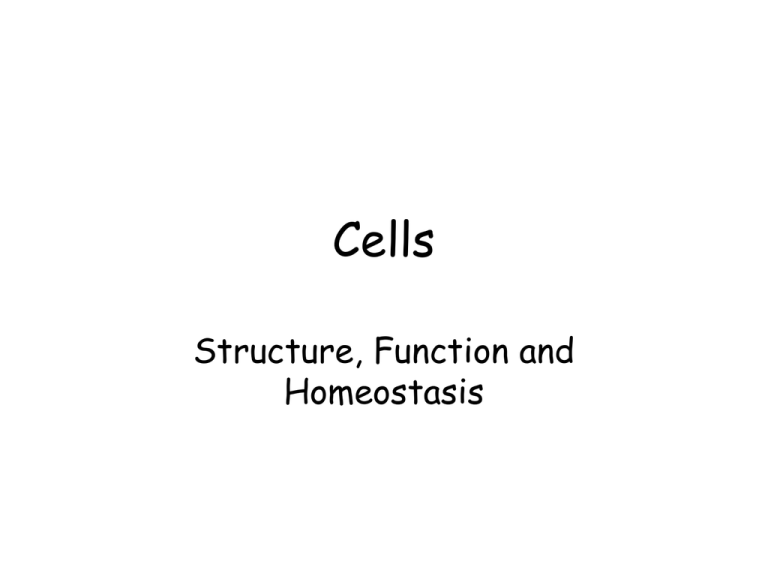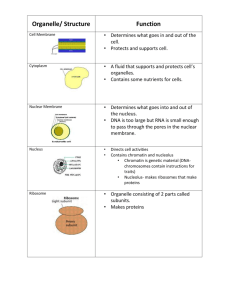Cells - Seattle Central College
advertisement

Cells Structure, Function and Homeostasis Characteristics of Cells • Basic unit of life; everything alive is made of cells • Have skeletons for protection and support (proteins) • Move (via proteins) • Communication (via hormones) • Harness & use Energy (produce enzymes, body heat) • Inheritance (maintains and copies blueprint for life) Cells are small • 10 – 100m • Must be small to minimize energy needs… • But large enough to minimize heat loss Size determines rate of life • Large enough to house organelles needed to eat, grow, reproduce • Small enough that verylittle energy & time is needed for transport of nutrients & waste • Maximize volume Simple Prokaryotic cells • Lack nuclei (have nucleoid region), few organelles • Small size Domains: Bacteria & Archaea • Wildly diverse – ~ 500 species in your mouth alone • Abundant (numerous) – 1012 on your skin; 1014 in G. I. tract; 1 teaspoon of soil contains billions • Ubiquitous – O2 free mud; salt flats; boiling hot springs; bedrock 1500 m deep; 10 km beneath ocean’s surface; 0˚- 121˚C 2/3 major evolutionary lineages Types of Eukaryotic cells Eukaryotic Animal cell • Nucleus • Smooth & Rough Endoplasmic Reticulum • Golgi Apparatus • Lysosomes ** • Peroxisomes • Plasma membrane • Mitochondria • Cytoskeleton • Centrioles ** • Flagellum ** Anatomy of Plant cell • Vacuole • Cloroplasts (& other plastids: amyloplasts) • Cell wall Nucleus: Control center (brain) Cytoplasm - organelles, free proteins, ions (guts) Cell (plasma) membrane barrier between inside and outside (skin) Questions for the cell • What structure controls which proteins, lipids & RNA are produced and when? • Where do cells get Energy? Which structures harness is? • What structures move stuff around the cell? • Where are proteins and lipids built? • How does the cell move stuff in and out? • How does it eat, drink and defend itself? Nucleus: Control center • Holds genetic code and “machinery” for replication and transcription • Bounded by nuclear envelope (inner and outer membrane) • Present in every cell at some life-stage •Nuclear pores •Chromatin •Chromosomes • Chromosomes? – Hypercoiled DNA • Chromatin? – Histone coiled DNA Nucleoli • Produce ribosomal RNA (rRNA) • Site of large and small ribosomal subunit formation via attachment of rRNA and ribosomal protein Where is the cytoplasm? • Between cell membrane & nuclear membrane • Consists of: – Cytosol: intracellular fluid (mostly H20, ions & buffering proteins) – Organelles: structures with specific functions; suspended in cytosol – Inclusions: Insoluble material (e.g. lipids) Ribosomes • Organ of protein synthesis • Made of 2 subunits; each made of rRNA + protein • Two varieties – Free ribosomes: produce proteins that travel to nucleus – Fixed ribosomes: produce proteins for export to Endoplasmic Reticulum (ER) Endoplasmic Reticulum (ER) • • Network of membranes connected to nuclear envelope 4 major functions 1. Synthesis (pro, carbs, lipids) 2. Storage 3. Transport 4. Detoxification • Two types 1. Smooth 2. Rough Smooth ER (SER) • Why is it called smooth? • Responsible for the synthesis and storage of: – Phospholipids and cholesterol 4 maintenance and growth of membranes of cell, ER, nucleus, Golgi apparatus (GA) What type of molecules? – Steroid hormones: estrogens and androgens – Glycerides in liver and fat cells – Glycogen in skeletal muscle and liver cells What type of molecules? Rough ER (RER) • Workshop • Site ofprotein synthesis (it has fixed ribosomes!!) May chemically modify them. – Polypeptide chains migrate into cisternae, assume tertiary structure + additional modification • Ships proteins to GA via transport vesicles Golgi Apparatus • Packing & shipping depot • Consists of 5-6 flattened membranous disks (cisternae) • Functions – Modifies (adds parts) & packages secretions – Renews cell membrane – Packages special enzymes Functions of GA • Produces 3 export vesicles: 1. Secretory - exocytosis 2. Membrane renewal – replacement & remodeling 3. Lysosomes - “Primary” contain inactive digestive enzymes Lysosome Functions Show “Lysosomes” Abnormal lysosomes • Lack, or have malfunctioning enzymes – Normal cell products accumulate & stifle (suffocate) cells • Tay-Sachs disease – Lysosomes lack enzymes that break down lipids in nerve cells • Pompe’s disease – Lysosomes lack hydrolytic enzyme that splits glycogen The endomembrane system allows membrane flow • Phospholipid bilayer is maintained! • Nuclear envelope continuous network of SER & RER transport vesicles Golgi Apparatus secretory vesicles cell membrane Peroxisomes • Functions: – Absorb and breakdown fatty acids and nucleic acids - produces H2O2 (danger!) – Convert free radicals to H2O2 – Coverts H2O2 to harmless H2O and O2, using catalase • Produced by division of existing peroxisomes • Contain digestive enzymes; produced @ free ribosomes Concept Check •The cell is sometimes described as a protein factory. Using the cell-as-factory analogy, which of the following accurately describes the functions of the endomembrane system? a) The ribosomes on the rough endoplasmic reticulum are analogous to a production line in a factory. b) The golgi apparatus is analogous to the packaging and shipping department. c) The nucleus is analogous to management offices. d) All of the above. • Answer The cell is sometimes described as a protein factory. Using the cell-as-factory analogy, which of the following accurately describes the functions of the endomembrane system? d) All of the above. Mitochondria = Powerhouse Mitochondria harness energy! • “powerhouse” of the cell…makes ATP • Double membrane • Number per cell varies with metabolic activity (0% volume of RBC, 20% volume of liver cell) Chloroplasts make food! • Photosynthetic eukaryotes • Converts light energy & CO2 to sugars • Stroma: tubules & membranous disks • Grana: stacks of disks; membranes chock full of chlorophyll, which traps solar energy Cell Membrane = Fluid Mosaic Structure of cell membrane • Contains lipids, proteins and carbohydrates – Lipids • Phospholipids; Cholesterol; Glycolipids – Proteins • Integral; Peripheral – Carbohydrates • Form glycocalyx (identity) Cell Membrane Functions • Physical isolation - separates inner and outer environments • Sensory receptor - receptor proteins sense changes in external environment (encrusted with peripheral nerves) • Regulates exchange with the environment - membrane channel proteins + carrier proteins • Structural support - intercellular protein attachment





